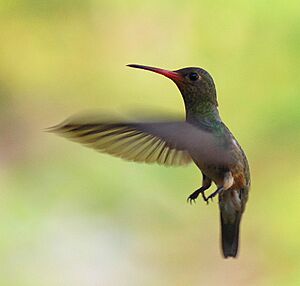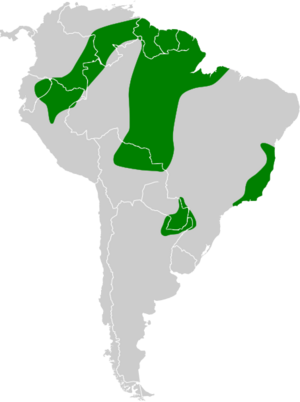Rufous-throated sapphire facts for kids
Quick facts for kids Rufous-throated sapphire |
|
|---|---|
 |
|
| female/immature male | |
| Conservation status | |
| Scientific classification | |
| Genus: |
Hylocharis
|
| Species: |
sapphirina
|
 |
|
| Synonyms | |
|
Rufous-throated hummingbird Amazilia sapphirina |
|
The rufous-throated sapphire (Hylocharis sapphirina) is a beautiful type of hummingbird. It belongs to a group of hummingbirds called "emeralds." You can find this tiny bird in many South American countries. These include Bolivia, Brazil, Colombia, Ecuador, the Guianas, Peru, and Venezuela. It might also live in Argentina and Paraguay.
Contents
About Its Name
Scientists first officially described this hummingbird in 1788. A German naturalist named Johann Friedrich Gmelin gave it the scientific name Trochilus sapphirinus. Later, most scientists decided to place it in the genus Hylocharis.
The name Hylocharis comes from Ancient Greek words. Hulē means "woodland" or "forest," and kharis means "beauty." So, its genus name means "woodland beauty." The second part of its scientific name, sapphirina, is from Latin. It means "sapphire-like," referring to its bright, jewel-like colors.
The rufous-throated sapphire is the only species in its group. This means there are no different types or subspecies of this particular bird.
What It Looks Like
The rufous-throated sapphire is a small bird, about 8.4 to 9.1 centimeters (3.3 to 3.6 inches) long. Males are a bit heavier than females.
Male birds have a straight, coral red beak with a black tip. Females have less red on their beaks. The bird gets its English name from the male's bright, reddish-orange chin. Females have a lighter reddish chin.
Adult males have dark green feathers on their upper body. Their throat, chest, and belly shine with a violet-blue color. The feathers under their tail are chestnut brown. Their tail feathers are mostly chestnut with some coppery and violet hints.
Adult females have similar green upper parts. Their underparts are grayish with sparkling blue-green spots on their throat and chest. Their tail looks like the male's but has lighter edges. Young birds look similar to adult females. However, young males have a richer reddish color on their chin.
Where It Lives and Its Home
The rufous-throated sapphire lives in three main areas. The largest area stretches from eastern Colombia across Venezuela, the Guianas, and northern Brazil. It also goes southwest into Ecuador and northern Peru. Another large area is in northeastern Brazil and northeastern Bolivia.
A second, smaller area is in southeastern Brazil. The third area includes southeastern Paraguay, northeastern Argentina, and nearby parts of Brazil. Scientists are still studying if it truly lives in Paraguay and Argentina, as clear evidence like photos is still needed.
This hummingbird likes semi-open areas. You can find it at the edges of forests, in savannas with scattered trees, and in clearings around rocky areas. It also lives in coffee plantations. It usually lives at elevations between 200 and 500 meters (660 to 1,640 feet) high. Sometimes, it can be found as high as 1,850 meters (6,070 feet).
Behavior
Movement
Scientists don't fully understand how the rufous-throated sapphire moves around. Generally, it stays in one place. However, in southeastern Brazil, it does migrate (move seasonally). In Venezuela, it appears and disappears, suggesting it might also move around there during different seasons.
Feeding
The rufous-throated sapphire eats nectar from many different kinds of flowers. These flowers grow on trees, shrubs, vines, and other plants. It usually feeds close to the ground or in the middle parts of the forest. In the Amazon, it might join other hummingbirds to feed at the tops of flowering trees. Male birds are very protective of their feeding spots.
Besides nectar, this hummingbird also eats insects. It catches insects by flying out from a perch, a behavior called "hawking." It also picks insects off leaves or from spiderwebs.
Reproduction
The breeding season for the rufous-throated sapphire is from July to January in the Guianas. In Brazil, it's from August to February. Scientists are still learning about its breeding times in other areas.
The female builds a cup-shaped nest. She uses plant fibers and lines it with soft seed fluff. She often decorates the outside with lichen and small pieces of leaves. The nest is usually placed on a horizontal branch under overhanging leaves. It's typically 3 to 6 meters (10 to 20 feet) above the ground, but sometimes as high as 10 meters (33 feet).
The female lays two eggs. She sits on them for 14 to 16 days until they hatch. The young birds leave the nest 22 to 27 days after hatching.
Vocalization
The songs of rufous-throated sapphires can be different depending on where they live. Birds in Venezuela sing a series of 4 to 7 bright, high-pitched notes. It sounds like "sping...sping...sping..." or "sping...spewee...spewee..." repeated every few seconds.
In the Amazon and southeastern Brazil, their song is a long, high-pitched, downward-sloping sound, like "seeeeeee." The bird's calls are a short, dry trill and a high-pitched "seep."
Status
The IUCN (International Union for Conservation of Nature) has listed the rufous-throated sapphire as a species of "least concern." This means it is not currently in danger of disappearing. We don't know the exact number of these birds or if their population is growing or shrinking. However, no immediate threats have been found. It is common in most places where it lives. It can even live in places changed by humans, like coffee plantations, as long as there are natural, semi-open areas nearby.


